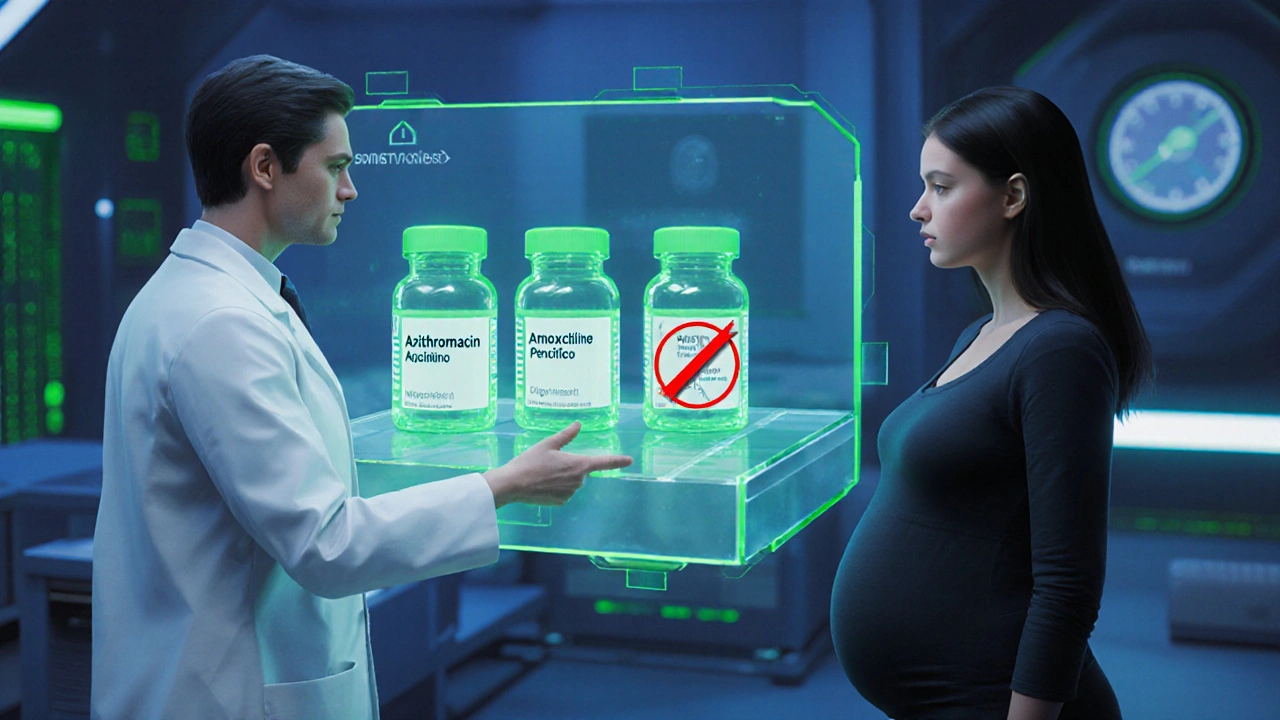Pregnancy Antibiotic Safety Checker
Check Antibiotic Safety in Pregnancy
Safety Information
Enter an antibiotic name to see safety information during pregnancy.
Imagine you’ve just been diagnosed with a stubborn skin infection and your doctor prescribes doxycycline. A few weeks later you discover you’re pregnant. Suddenly the medication’s safety becomes a pressing question: Is doxycycline safe for a developing baby?
Below we unpack the science, the official guidelines, and practical steps to protect both mom and child.
What is Doxycycline?
Doxycycline is a broad‑spectrum tetracycline antibiotic that works by inhibiting bacterial protein synthesis. First approved in 1967, it’s used for acne, Lyme disease, chlamydia, and certain respiratory infections. Its long half‑life and high tissue penetration make it a favorite for clinicians, but those same properties raise concerns during pregnancy.
Why Pregnancy Matters for Antibiotics
Pregnancy is a unique physiological state where drugs cross the placenta to reach the fetus. The developing organs are especially vulnerable during the first trimester, when organogenesis occurs. Therefore, any medication’s ability to reach the fetus, its intrinsic toxicity, and the timing of exposure all dictate risk.
Regulatory Stance: FDA and Professional Guidelines
The U.S. Food and Drug Administration (FDA) historically placed doxycycline in Pregnancy Category D, meaning positive evidence of risk, but potential benefits may outweigh the risks in certain situations. In 2015, the FDA replaced the letter categories with a narrative risk summary, yet the core caution remains.
The American College of Obstetricians and Gynecologists (ACOG) advises that doxycycline should be avoided unless no safer alternative exists. Their committee’s rationale rests on animal studies showing tooth discoloration and growth plate effects in fetuses.
Potential Risks to the Fetus
- Dental enamel staining: Tetracyclines bind to calcium in developing teeth, leading to yellow‑brown discoloration that can be permanent.
- Inhibition of bone growth: Animal data indicate altered growth‑plate development, especially concerning in the second and third trimesters.
- Possible hepatotoxicity: Rare liver enzyme elevations have been reported in pregnant patients.
Human data are limited, but case series and registries suggest an association with dental effects when exposure occurs after the first trimester. The risk appears lower if exposure stops before 20 weeks gestation, yet uncertainty persists.
When Might Doxycycline Still Be Considered?
In rare scenarios-such as severe rickettsial infections (e.g., Rocky Mountain spotted fever) where doxycycline is the drug of choice-benefits may outweigh the theoretical risks. In those cases, clinicians typically follow these steps:
- Confirm pregnancy status early with a reliable test.
- Discuss the absolute need for doxycycline versus alternative agents.
- If doxycycline is chosen, limit use to the shortest effective duration.
- Schedule detailed fetal ultrasound monitoring for dental and skeletal anomalies.
Safer Antibiotic Alternatives
For most infections that doxycycline treats, safer options exist. Below is a quick side‑by‑side look.
| Antibiotic | FDA Pregnancy Category (Pre‑2015) | Placental Transfer | Typical Use in Pregnancy | Known Fetal Risks |
|---|---|---|---|---|
| Doxycycline | Category D | High | Acne, Lyme, atypical pneumonia (rare) | Dental staining, possible bone growth effects |
| Azithromycin | Category B | Moderate | Chlamydia, respiratory infections | Generally considered safe; limited data on rare anomalies |
| Amoxicillin | Category B | Low to moderate | UTI, otitis media, bacterial sinusitis | No teratogenic signal; safe in all trimesters |
| Penicillin V | Category B | Low | Strep infections, syphilis | Safe; long‑standing use in pregnancy |

What to Do If You’ve Already Taken Doxycycline
First, stay calm. A single short course early in pregnancy rarely causes permanent harm. Here’s a practical plan:
- Contact your obstetrician or a maternal‑fetal medicine specialist promptly.
- Ask for a detailed fetal ultrasound around 18‑20 weeks to assess tooth buds and bone growth plates.
- If you’re still in the first trimester, discuss switching to a safer antibiotic for any remaining treatment.
- Document the exact dosage, dates, and indication-this helps the clinician weigh risk.
Most healthcare providers will reassure you that the overall risk of major defects is low, but vigilant monitoring is the best safety net.
Key Takeaways for Expectant Parents
- Doxycycline carries a Category D label due to documented dental and skeletal concerns in animal studies and limited human data.
- Reserve doxycycline for life‑threatening infections where no safer alternative works.
- Prefer azithromycin, amoxicillin, or penicillin for common infections during pregnancy.
- If exposure occurs, schedule a mid‑trimester ultrasound and discuss a possible switch with your provider.
- Open communication with your healthcare team is essential; never stop a prescribed antibiotic without professional advice.
Frequently Asked Questions
Can I take doxycycline for acne while pregnant?
No. Acne treatment with doxycycline is not recommended during pregnancy because safer topical options or antibiotics like erythromycin are available. Discuss alternatives with your dermatologist.
What evidence links doxycycline to tooth discoloration in babies?
Animal studies repeatedly show doxycycline binding to calcium in developing dentin, causing yellow‑brown staining. Human case reports are scarce but consistent enough for regulatory caution.
Is a single dose of doxycycline harmful?
A single low dose is unlikely to cause permanent damage, especially if taken before the 12‑week mark. Nonetheless, inform your provider so they can arrange appropriate monitoring.
Which antibiotics are considered safest for urinary tract infections in pregnancy?
Amoxicillin, ampicillin, and nitrofurantoin (avoiding the last trimester) are first‑line choices. They have extensive safety data and are classified as Category B.
If I need treatment for RockyMountain spotted fever, can I still avoid doxycycline?
Current CDC guidelines recommend doxycycline for all ages, including pregnant women, because untreated infection carries a higher mortality risk. In such cases, the benefit outweighs the potential fetal risk.


Suzanne Podany
October 15, 2025 AT 17:53If you discover you’re pregnant while taking doxycycline, the most important move is to schedule a timely appointment with your obstetrician. They will review the dose, duration, and timing of exposure, then discuss whether switching to a safer alternative is warranted. Open communication also lets you plan the appropriate mid‑trimester ultrasound to check dental buds and bone growth. Remember, you’re not alone-many clinicians have navigated this scenario and can guide you safely.
Sunil Kamle
October 16, 2025 AT 05:00It is, of course, entirely logical to prescribe a Category D medication without confirming a patient’s pregnancy status; after all, who needs precaution when you have confidence, right? Nonetheless, the guidelines do exist for a reason, and a brief urine test can spare a lot of needless worry. Stay optimistic-medicine does love a good challenge, even if it comes wrapped in a dose of irony.
Ben Lee
October 16, 2025 AT 16:06Doxycycline’s pharmacokinetic profile makes it a go‑to drug for a wide range of infections, but that same profile raises red flags during gestation. The molecule readily crosses the placenta, delivering high concentrations to fetal tissues, which is why regulatory agencies have placed it in Category D. Animal models have repeatedly demonstrated calcium binding in developing dentin, leading to permanent discoloration of teeth, a finding that translates into caution for human use. Moreover, studies in rodents have shown altered growth‑plate morphology, suggesting a theoretical risk to skeletal development. Human data, while scarce, include case series where children exposed after the first trimester presented with mottled enamel. The FDA’s narrative risk summary emphasizes that the benefit‑risk calculus must heavily favor the benefit when considering doxycycline in pregnancy. In most dermatologic cases, such as acne, the benefit is modest, and alternatives like erythromycin or clindamycin are readily available. For respiratory infections like atypical pneumonia, macrolides provide comparable efficacy with a more favorable safety profile. When dealing with Lyme disease, oral amoxicillin is often effective and carries a robust safety record. Even in severe rickettsial infections, the CDC still recommends doxycycline as the drug of choice, but it also advises close fetal monitoring if the patient is pregnant. The practical steps, therefore, begin with confirming pregnancy status early and discussing the absolute necessity of doxycycline versus other agents. If doxycycline remains the only viable option, clinicians should limit the course to the minimal effective duration and schedule a detailed ultrasound around 18‑20 weeks to assess dental buds and bone growth plates. Documentation of dose, timing, and indication is crucial for both the patient’s peace of mind and for contributing to registries that improve our collective knowledge. Counseling should stress that a short, early exposure typically carries a low risk of major defects, but vigilance remains essential. Ultimately, the decision rests on a shared, informed discussion that balances maternal health needs with fetal safety considerations.
Stacy Whitman
October 17, 2025 AT 03:13The American guidelines are clear: doxycycline should be a last‑resort choice for pregnant patients, and that stance reflects our commitment to protecting the next generation of citizens.
Kim and Lin
October 17, 2025 AT 14:20Switching to azithromycin is the smart move-don’t overcomplicate things :)
Kemari Nielson
October 18, 2025 AT 01:26Document the exact dosage and timing; this information is essential for accurate risk assessment.
Steve Helsel
October 18, 2025 AT 12:33Honestly, most of these precautions are just textbook filler; the real risk is negligible.
Mina Berens
October 18, 2025 AT 23:40It’s wild how a single antibiotic can spark so much anxiety, but staying informed really helps 😊. The mid‑trimester scan is a great way to catch any unexpected changes early.
Jessie Eerens
October 19, 2025 AT 10:46In the grand tapestry of pharmacology, doxycycline occupies a curious niche; it is both a therapeutic ally and a potential hazard, depending on the temporal context of its administration, the physiological state of the mother, and the developmental stage of the fetus, all of which intertwine to form a complex risk landscape, demanding careful deliberation, meticulous documentation, and open dialogue between patient and provider.
Moritz Bender
October 19, 2025 AT 21:53From a pharmacodynamic standpoint, doxycycline inhibits the 30S ribosomal subunit, thereby preventing protein synthesis; however, its high lipophilicity facilitates extensive placental transfer, which is why alternatives such as beta‑lactams (e.g., amoxicillin) or macrolides (e.g., azithromycin) are preferred in obstetric care. Monitoring serum trough levels isn’t typically necessary, but a targeted ultrasound at 18–20 weeks can assess dental bud mineralization and epiphyseal plate integrity. If you need a rapid switch, use a loading dose of amoxicillin-clavulanate, then transition to a full course of azithromycin. Hope this clears things up! :)
Nicole Hernandez
October 20, 2025 AT 09:00It is reassuring to see the emphasis on collaborative decision‑making between clinicians and expectant mothers, as this approach optimizes both maternal health outcomes and fetal safety. Continued research into the pharmacokinetics of tetracyclines in pregnancy will further refine our guidelines.
florence tobiag
October 20, 2025 AT 20:06Sure, the FDA’s narrative sounds reassuring, but have you considered the possibility that selective data reporting is influencing the public perception? The pharmaceutical lobby, the same entities that profit from antibiotics, could be shaping the guidelines to downplay long‑term dental effects-an agenda that aligns perfectly with their market interests!!!
Terry Washington
October 21, 2025 AT 07:13One must acknowledge the moral imperative to prioritize the unborn child over any convenience the prescriber might seek; prescribing doxycycline without exhaustive justification borders on ethical negligence, especially when safer, equally efficacious alternatives exist within the armamentarium of obstetric pharmacotherapy.
Claire Smith
October 21, 2025 AT 18:20While the discussion is thorough, the repetitive emphasis on ultrasound monitoring borders on overkill.